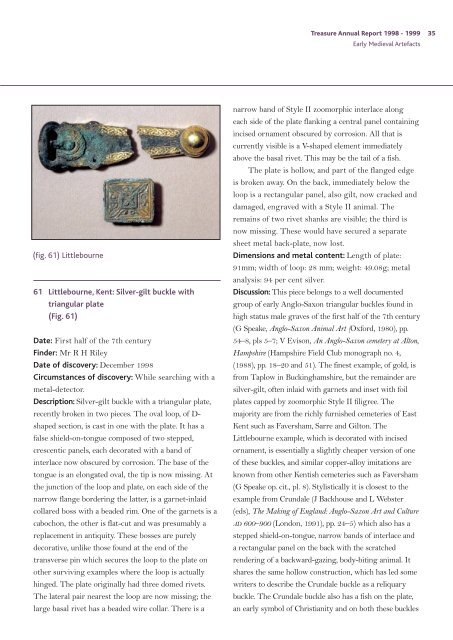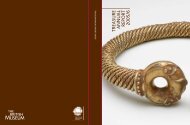Treasure Annual Report 1998-1999 - Portable Antiquities Scheme
Treasure Annual Report 1998-1999 - Portable Antiquities Scheme
Treasure Annual Report 1998-1999 - Portable Antiquities Scheme
You also want an ePaper? Increase the reach of your titles
YUMPU automatically turns print PDFs into web optimized ePapers that Google loves.
(fig. 61) Littlebourne<br />
61 Littlebourne, Kent: Silver-gilt buckle with<br />
triangular plate<br />
(Fig. 61)<br />
Date: First half of the 7th century<br />
Finder: Mr R H Riley<br />
Date of discovery: December <strong>1998</strong><br />
Circumstances of discovery: While searching with a<br />
metal-detector.<br />
Description: Silver-gilt buckle with a triangular plate,<br />
recently broken in two pieces. The oval loop, of Dshaped<br />
section, is cast in one with the plate. It has a<br />
false shield-on-tongue composed of two stepped,<br />
crescentic panels, each decorated with a band of<br />
interlace now obscured by corrosion. The base of the<br />
tongue is an elongated oval, the tip is now missing. At<br />
the junction of the loop and plate, on each side of the<br />
narrow flange bordering the latter, is a garnet-inlaid<br />
collared boss with a beaded rim. One of the garnets is a<br />
cabochon, the other is flat-cut and was presumably a<br />
replacement in antiquity. These bosses are purely<br />
decorative, unlike those found at the end of the<br />
transverse pin which secures the loop to the plate on<br />
other surviving examples where the loop is actually<br />
hinged. The plate originally had three domed rivets.<br />
The lateral pair nearest the loop are now missing; the<br />
large basal rivet has a beaded wire collar. There is a<br />
<strong>Treasure</strong> <strong>Annual</strong> <strong>Report</strong> <strong>1998</strong> - <strong>1999</strong> 35<br />
Early Medieval Artefacts<br />
narrow band of Style II zoomorphic interlace along<br />
each side of the plate flanking a central panel containing<br />
incised ornament obscured by corrosion. All that is<br />
currently visible is a V-shaped element immediately<br />
above the basal rivet. This may be the tail of a fish.<br />
The plate is hollow, and part of the flanged edge<br />
is broken away. On the back, immediately below the<br />
loop is a rectangular panel, also gilt, now cracked and<br />
damaged, engraved with a Style II animal. The<br />
remains of two rivet shanks are visible; the third is<br />
now missing. These would have secured a separate<br />
sheet metal back-plate, now lost.<br />
Dimensions and metal content: Length of plate:<br />
91mm; width of loop: 28 mm; weight: 49.08g; metal<br />
analysis: 94 per cent silver.<br />
Discussion: This piece belongs to a well documented<br />
group of early Anglo-Saxon triangular buckles found in<br />
high status male graves of the first half of the 7th century<br />
(G Speake, Anglo-Saxon Animal Art (Oxford, 1980), pp.<br />
54–8, pls 5–7; V Evison, An Anglo-Saxon cemetery at Alton,<br />
Hampshire (Hampshire Field Club monograph no. 4,<br />
(1988), pp. 18–20 and 51). The finest example, of gold, is<br />
from Taplow in Buckinghamshire, but the remainder are<br />
silver-gilt, often inlaid with garnets and inset with foil<br />
plates capped by zoomorphic Style II filigree. The<br />
majority are from the richly furnished cemeteries of East<br />
Kent such as Faversham, Sarre and Gilton. The<br />
Littlebourne example, which is decorated with incised<br />
ornament, is essentially a slightly cheaper version of one<br />
of these buckles, and similar copper-alloy imitations are<br />
known from other Kentish cemeteries such as Faversham<br />
(G Speake op. cit., pl. 8). Stylistically it is closest to the<br />
example from Crundale (J Backhouse and L Webster<br />
(eds), The Making of England: Anglo-Saxon Art and Culture<br />
AD 600–900 (London, 1991), pp. 24–5) which also has a<br />
stepped shield-on-tongue, narrow bands of interlace and<br />
a rectangular panel on the back with the scratched<br />
rendering of a backward-gazing, body-biting animal. It<br />
shares the same hollow construction, which has led some<br />
writers to describe the Crundale buckle as a reliquary<br />
buckle. The Crundale buckle also has a fish on the plate,<br />
an early symbol of Christianity and on both these buckles





